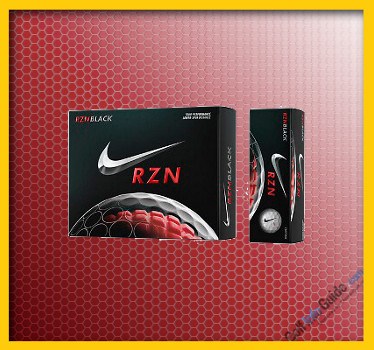
Ball tested: Nike RZN Black
Category: Tour/Advanced/Performance
Feel: Soft
Tested for golfers with average driving distance of: 196 to 300+ yards (carry + roll)
Specs: Construction – Four-piece; Cover – Urethane; Core – Polymer resin; Dimples / Pattern – 360 in seamless design
Compression: High
Price as tested (new): $46 per dozen
Ball notes: We could tell you Nike’s RZN Black model is the golf ball used by Tiger Woods and Rory McIlroy, and that alone might convince you to play it. But that wouldn’t be fair of us – nor smart of you.
We’ll get to our review momentarily. First, a little background.
The RZN Black is one of four balls in Nike’s new-for-2014 RZN lineup. It’s one of two “tour” models, along with the higher-spinning Platinum, aimed at skilled golfers with strong swing speeds (105-plus mph with the driver). The lower-priced White and Red versions are designed for slower swinging amateurs.
The RZN Black and Platinum replace Nike’s 20XI and 20XI-X golf balls. The new models feature a revamped resin core and “Speedlock” construction, touted by Nike to bind each layer more tightly together for greater in-flight stability.
Essentially, Nike claims the RZN Black is longer and straighter off the tee thanks to reduced spin, more stable in windy conditions due to the stronger outer layers, and delivers better greenside control with a urethane cover coated in “spin-optimized” material.
Let’s put the Nike RZN Black to the test to verify – or debunk – those claims.
On the clubface: Nike keeps tweaking its RZN core, and it keeps getting better. As in softer. There’s a pretty noticeable difference between the RZN Black and the 20XI models, which were notably softer than their predecessors. Nike can honestly brag about making a ball that stacks up to the industry heavyweights, including the Titleist ProV1, for tee-to-green feel.
To be sure, there are softer balls available than the Nike RZN Black. (The Platinum version, for example.) This one occupies a very pleasing middle ground, though, between the softest and firmest tour balls.
Off the tee: Very impressive. Not only does the RZN Black sport long hang time and excellent accuracy, it penetrates the wind like a champ. While no ball is completely immune to getting knocked off course by a stiff crossing breeze, this one holds its line remarkably well. Its low-spin characteristics keep headwinds from affecting it too much as well.
From the fairway / rough: Here’s where you can start to tell the difference between the RZN Black and Platinum models. The Black spins plenty for most golfers, and really hits the sweet spot for those who generate ample or excess spin. It’s also pretty workable left and right, and adjusts well to trajectory commands from advanced players.
Golfers whose swings generate lower RPMs might find the Platinum more to their liking, if big-time spin is a priority.
Around the green: All the driving distance and flight stability in the world wouldn’t convince pros to play a ball that didn’t perform in the short game. As expected, the RZN Black does everything you can ask of a tour ball on chips, pitches and bunker shots. It’s also got a slightly softer feel and sound than previous Nike iterations, which is a nice bonus when putting.
Bottom line: Slowly but surely, Nike has crept up on golf’s major ball manufacturers for overall performance. The RZN lineup, including the Black model, marks yet another step in the right direction – in fact, we’d say it closes any perceived gap that still existed. It’s soft but not squishy, gives up nothing in the distance or accuracy departments, offers the right amount of spin for a large portion of golfers and, best of all, performs beautifully in windy weather.
Kudos to Tiger and Rory. They picked a winner.
Golf Ball Videos:
– Compression Video
– Spin Video
– Dimples Video
– Golf Ball Brands Video
– Titleist Video
– Understanding Spin Video
Categories Explained:
Value/Recreational/Distance – Designed for mid- to high-handicap golfers with swing speeds below 90 mph; typically feature two-piece construction and firm covers; promote greater distance over high spin rates. Examples: Pinnacle Gold, Slazenger RAW Distance
Premium – Designed for low- to mid-handicap golfers with swing speeds of 90-99 mph; typically feature multi-layer construction and medium-soft covers; happy medium between Value/Recreational and Tour categories for distance and spin qualities. Examples: Titleist NXT Tour, Callaway HEX Diablo
Tour/Advanced/Performance – Designed for low-handicap and professional golfers with swing speeds in excess of 100 mph; typically feature multi-layer construction and soft covers; promote greater spin rates and enhanced feel over distance. Examples: Titleist ProV1, Bridgestone Tour B330





